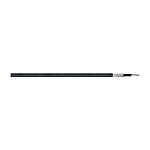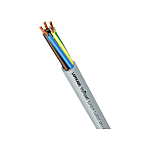Control/Instrumentation Cables(Finished outer diameter:7,6)
| Shipping Days |
|
|---|
?* Information on days to ship and prices
-

Extension- and compensating cables, paired
LAPP
Benefits
· For more detailed information, see appendix T8 and data sheets
· Space-saving and flexible
Application
· Conductor materials (alloys): Fe/CuNi (LX, JX)Conductor alloys are identical to thermocouple alloys
· The thermocouple is used to measure temperature as a part of monitoring the manufacturing process, thus the sheath material should be selected with reference to the maximum ambient temperature at its junction
· PtRh/Pt (RCB, SCB)Compensating alloys (for RCB, SCB: Cu/CuNi) are not identical to thermocouple alloys
· NiCr/Ni (K, KX, KCA)K and KX version - conductor alloys are identical to thermocouple alloysKCA version: compensating alloys (for KCA: Fe/CuNi), not identical to thermocouple alloys
· Allows temperature measurement even in places where non-contact temperature measurement is not possible or reasonable- Volume Discount
Configure nowStarting from∗ : 613.15 € Min. Shipping Days : 5 Days *Unit price with basic configuration
-

ÖLFLEX® CLASSIC 100 H
LAPP
Benefits
· VDE-tested fire behaviour
· Classified fire behaviour according to EU Directive 305/2011 (BauPVO/CPR) with article number selection on the LAPP website
· High electrical safety thanks to 4000 V test voltage
· Halogen free and highly flame retardant materials reduce the risk of flame propagation, high smoke density and toxic flue gases in the event of a fire
· High oil resistance according to DIN EN 50363-4-1 (TM5), as well as UL OIL RES I and OIL RES II
· Easy handling and installation due to very flexible design
Application
· Suitable for medium mechanical stress
· For circuits that require a higher nominal voltage due to their installation
· For fixed installation and occasional flexing without tensile strain
· Can be used in dry and damp rooms
· Flexible use at temperatures down to -30°C
· For universal use for wiring machine-internal and cross-plant control circuits
· Cable design also suitable for torsion applications in wind turbines
· For structured building cabling for fulfilling special fire protection requirements
· The HFFR outer sheath is highly resistant to acids and alkalis- Volume Discount
Configure nowStarting from∗ : 234.65 € Min. Shipping Days : 8 Days *Unit price with basic configuration
| Brand |
|---|
| Product Series |
| Starting from∗ |
| Min. Shipping Days |
| Overall Length(m) |
| Specified Length(m) |
| Conductor Cross Section(mm2) |
| AWG size(AWG) |
| Number Of Cores(Core) |
| Finished outer diameter(mm) |
| Rated Voltage |
| Shield |
| Properties |
| Representative Standard |
| Sheath (outer coating) color |
| Grounding Wire |
| Sheath (outer coating) material |
| Insulation body materials |
| Brand | LAPP | LAPP |
|---|---|---|
| Product Series | ||
| Starting from∗ | 613.15 € *Unit price with basic configuration Volume Discount | 234.65 € *Unit price with basic configuration Volume Discount |
| Min. Shipping Days | 5 Days | 8 Days |
| Overall Length(m) | - | - |
| Specified Length(m) | 100 ~ 1000 | 100 ~ 1000 |
| Conductor Cross Section(mm2) | 1,5 | 1,5 |
| AWG size(AWG) | - | - |
| Number Of Cores(Core) | - | 2 |
| Finished outer diameter(mm) | 7,6 | 7,6 |
| Rated Voltage | - | - |
| Shield | - | - |
| Properties | - | - |
| Representative Standard | - | - |
| Sheath (outer coating) color | Black / White / Orange / Green / Blue | Gray |
| Grounding Wire | - | - |
| Sheath (outer coating) material | PVC (Polyvinyl Chloride) | Other |
| Insulation body materials | - | - |
Loading...
Filter by:
-
Overall Length(m)
-
Specified Length(m)
-
Conductor Cross Section(mm2)
-
AWG size(AWG)
-
Number Of Cores(Core)
-
Finished outer diameter(mm)
-
Rated Voltage
- 300V
-
Shield
-
Properties
- Oil Resistance
-
Representative Standard
-
Sheath (outer coating) color
- Black
- Gray
- White
- Brown
- Red
- Orange
- Yellow
- Green
- Blue
- Other
-
Grounding Wire
- GY (green/yellow) colored
- N/A
-
Sheath (outer coating) material
- PVC (Polyvinyl Chloride)
- Polyester-Based
- Urethane-Based
- Rubber-Based
- Other
-
Insulation body materials
- Polyethylene-Based
- Polyester-Based
Brand
CAD data type
-
- 2D
- 3D










